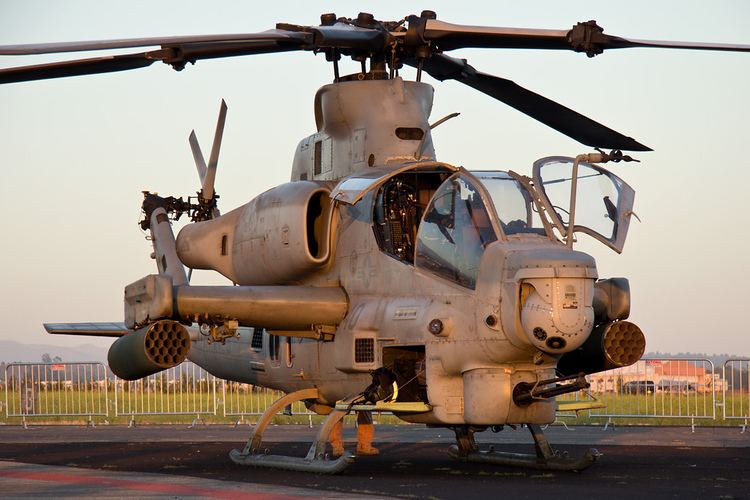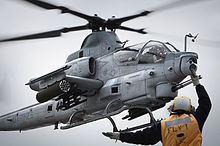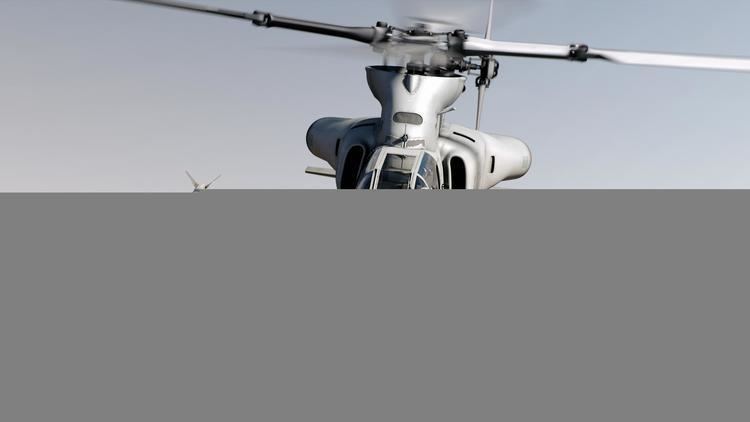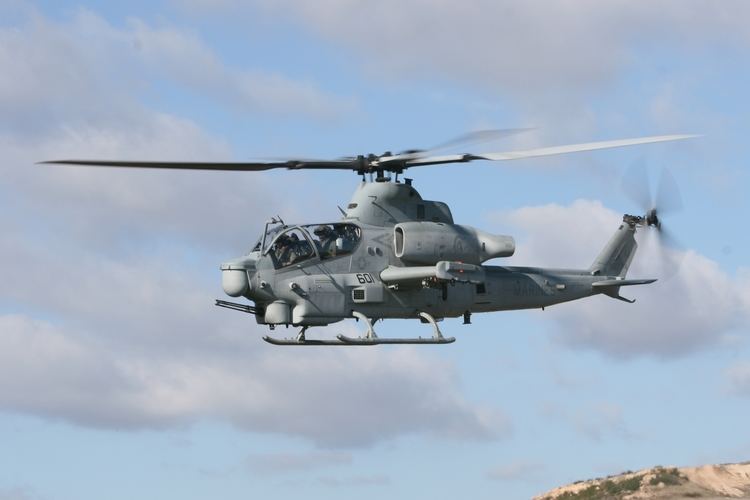Top speed 411 km/h Weight 5,580 kg | Range 685 km Length 18 m Manufacturer Bell Helicopter | |
 | ||
Unit cost 27,000,000–31,000,000 USD (2011) Similar Boeing AH-64 Apache, Bell Boeing V-22 Osprey, Bell UH-1Y Venom, Sikorsky CH-53E Super Stallion | ||
Bell ah 1z viper usmc s new attack helicopter
The Bell AH-1Z Viper is a twin-engine attack helicopter based on the AH-1W SuperCobra, that was developed for the United States Marine Corps as part of the H-1 upgrade program. The AH-1Z features a four-blade, bearingless, composite main rotor system, uprated transmission, and a new target sighting system. The AH-1Z, one of the latest members of the prolific Huey family, is also called "Zulu Cobra", in reference to its variant letter based on the military phonetic alphabet (Zulu for Z).
Contents
- Bell ah 1z viper usmc s new attack helicopter
- Bell ah 1z viper attack helicopter is the most revolutionary
- Background
- H 1 upgrade program
- Design
- Operational history
- Foreign interest
- Operators
- Specifications AH 1Z
- References

Bell ah 1z viper attack helicopter is the most revolutionary
Background

Aspects of the AH-1Z date back to the Bell 249 in 1979, which was basically an AH-1S equipped with the four-blade main rotor system from the Bell 412. This helicopter demonstrated Bell's Cobra II design at the Farnborough Airshow in 1980. The Cobra II was to be equipped with Hellfire missiles, a new targeting system and improved engines. Later came the Cobra 2000 proposal which included General Electric T700 engines and a four-blade rotor. This design drew interest from the US Marine Corps, but funding was not available. In 1993, Bell proposed an AH-1W-based version for the UK's new attack helicopter program. The derivative design, named CobraVenom, featured a modern digital cockpit and could carry TOWs, Hellfire or Brimstone missiles. The CobraVenom design was altered in 1995 by changing to a four-blade rotor system. The design lost to the AH-64D later that year however.
H-1 upgrade program

In 1996, the USMC launched the H-1 upgrade program by signing a contract with Bell Helicopter for upgrading 180 AH-1Ws into AH-1Zs and upgrading 100 UH-1Ns into UH-1Ys. The H-1 program created completely modernized attack and utility helicopters with considerable design commonality to reduce operating costs. The AH-1Z and UH-1Y share a common tailboom, engines, rotor system, drivetrain, avionics architecture, software, controls and displays for over 84% identical components.

Bell participated in a joint Bell-Government integrated test team during the engineering manufacturing development (EMD) phase of the H-1 program. The AH-1Z program progressed slowly from 1996 to 2003 largely as a research and development operation. The existing two-blade semi-rigid, teetering rotor system is being replaced with a four-blade, hingeless, bearingless rotor system. The four-blade configuration provides improvements in flight characteristics including increased flight envelope, maximum speed, vertical rate of climb, payload and reduced rotor vibration level.

The AH-1Z first flew on 8 December 2000. Bell delivered three prototype aircraft to the United States Navy's Naval Air Systems Command (NAVAIR) at Naval Air Station Patuxent River in July 2002, for the flight test phase of the program. Low-rate initial production began in October 2003, with deliveries to run through 2018. In late 2006 NAVAIR awarded a contract to Meggitt Defense Systems to develop a new linkless 20 mm ammunition handling system to improve on the gun feed reliability of the existing linked feed system. These systems are now being retrofitted into the AH-1W and AH-1Z fleets with good results during combat in Afghanistan.

In February 2008, the U.S. Navy adjusted the contract so the last 40 AH-1Zs are built as new airframes instead of the previously planned rebuild of AH-1Ws. In September 2008, the Navy requested an additional 46 airframes for the Marine Corps, bringing the total number ordered to 226. In 2010, the Marine Corps planned to order 189 AH-1Zs with 58 of them being new airframes, with deliveries to continue until 2019. On 10 December 2010, the Department of the Navy approved the AH-1Z for full-rate production.
Design

The AH-1Z incorporates new rotor technology with upgraded military avionics, weapons systems, and electro-optical sensors in an integrated weapons platform. It has improved survivability and can find targets at longer ranges and attack them with precision weapons.
The AH-1Z's new bearingless, hingeless rotor system has 75% fewer parts than that of four-bladed articulated systems. The blades are made of composites, which have an increased ballistic survivability, and there is a semiautomatic folding system for storage aboard amphibious assault ships. Its two redesigned wing stubs are longer, with each adding a wingtip station for a missile such as the AIM-9 Sidewinder. Each wing has two other stations for 2.75-inch (70 mm) Hydra 70 rocket pods, or AGM-114 Hellfire quad missile launchers. The AN/APG-78 Longbow fire control radar can also be mounted on a wingtip station.
The Z-model's integrated avionics system (IAS) has been developed by Northrop Grumman. The system includes two mission computers and an automatic flight control system. Each crew station has two 8×6-inch multifunction liquid crystal displays (LCD) and one 4.2×4.2-inch dual function LCD display. The communications suite combines a US Navy RT-1824 integrated radio, UHF/VHF, COMSEC and modem in a single unit. The navigation suite includes an embedded GPS inertial navigation system (EGI), a digital map system and Meggitt's low-airspeed air data subsystem, which allows weapons delivery when hovering.
The crew are equipped with the Thales "Top Owl" helmet-mounted sight and display system. The Top Owl has a 24-hour day/night capability and a binocular display with a 40° field of view. Its visor projection provides forward looking infrared (FLIR) or video imagery. The AH-1Z has survivability equipment including the Hover Infrared Suppression System (HIRSS) to cover engine exhausts, countermeasure dispensers, radar warning, incoming/on-way missile warning, and on-fuselage laser spot warning systems.
The Lockheed Martin Target Sight System (TSS) incorporates a third-generation FLIR sensor. The TSS provides target sighting in day, night, or adverse weather conditions. The system has various view modes and can track with FLIR or by TV. The same system is also used on the KC-130J Harvest HAWK.
Operational history
The AH-1Z completed sea-trial flight testing in May 2005. On 15 October 2005, the USMC, through the Naval Air Systems Command, accepted delivery of the first AH-1Z production helicopter to enter the fleet. The AH-1Z and UH-1Y completed their developmental testing in early 2006. During the first quarter of 2006 the aircraft were transferred to the Operational Test Unit at the NAS Patuxent River, where they began operational evaluation (OPEVAL) testing.
In February 2008, the AH-1Z and UH-1Y began the second and final portion of OPEVAL testing. AH-1Z testing was stopped in 2008 due to issues with its targeting systems. The AH-1Z was later declared combat-ready in September 2010.
Foreign interest
In 2000, the Turkish Army selected the AH-1Z for procurement; this was later cancelled in 2004. In September 2012, the U.S. Congress was notified of the possible Foreign Military Sales (FMS) for 36 AH-1Z Vipers and associated equipment and weapons by South Korea. The Viper was competing against the Boeing AH-64 Apache and the TAI/AgustaWestland T129 for the order; a decision was expected by the end of 2012. In April 2013, South Korea announced the selection of the AH-64E.
In April 2015, the U.S. State Department approved a possible FMS sale to Pakistan for 15 AH-1Z Vipers with Hellfire missiles, associated equipment and support worth up to $952 million. Pakistan is to receive 9 AH-1Z helicopters by September 2018. Bell is also interested in selling the AH-1Z to Poland and Czech Republic, which are going to retire their Mil Mi-24s.
In November 2016, Bell Helicopter signed a memorandum of understanding with Romanian airspace company IAR – Ghimbav Brasov Group for potential collaboration on the AH-1Z Viper.
Operators
Specifications (AH-1Z)
Data from Bell Specifications, The International Directory of Military Aircraft, 2002–2003, Modern Battlefield Warplanes
General characteristics
Performance
Armament
